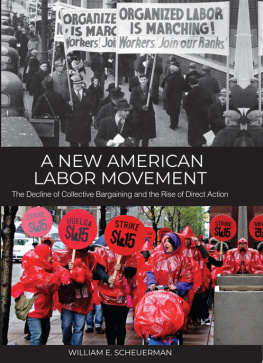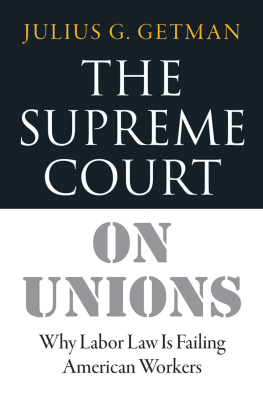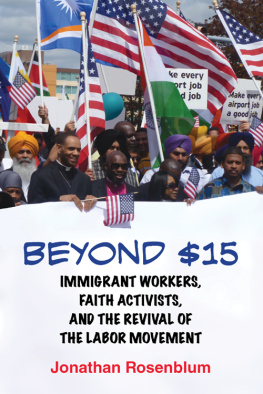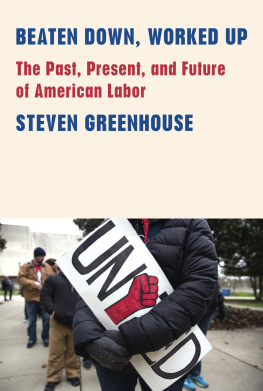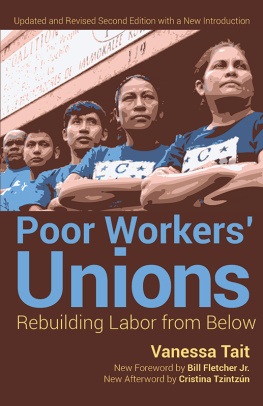Thank you for buying this ebook, published by NYU Press.
Sign up for our e-newsletters to receive information about forthcoming books, special discounts, and more!
Sign Up!
About NYU Press
A publisher of original scholarship since its founding in 1916, New York University Press Produces more than 100 new books each year, with a backlist of 3,000 titles in print. Working across the humanities and social sciences, NYU Press has award-winning lists in sociology, law, cultural and American studies, religion, American history, anthropology, politics, criminology, media and communication, literary studies, and psychology.
CAN UNIONS SURVIVE?
CAN UNIONS SURVIVE?
The Rejuvenation of the American Labor Movement
Charles B. Craver

NEW YORK UNIVERSITY PRESS
New York and London
Copyright 1993, 1995 by New York University
All rights reserved
Library of Congress Cataloging-in-Publication Data
Craver, Charles B.
Can unions survive? : the rejuvenation of the American labor
movement/Charles B. Craver.
p. cm.
Includes bibliographical references and index.
ISBN 0-8147-1498-6 ISBN 0-8147-1512-5 pbk
1. Trade-unionsUnited StatesHistory. 2. Labor movement
United StatesHistory. 3. Industrial relationsUnited States
History. 4. Labor laws and legislationUnited StatesHistory.
I. Title. HD6508.C739 1993 92-40980
331.880973dc20 CIP
New York University Press books are printed on acid-free paper,
and their binding materials are chosen for strength and durability.
Manufactured in the United States of America
10 9 8 7 6 5 4 3 2
Dedicated to American Workers,
Many of Whom Need a Collective Voice
to Counter the Economic Power
of Their Corporate Employers.
CONTENTS
ACKNOWLEDGMENTS
The foundation for this project began to develop while I was a graduate student at the New York State School of Industrial and Labor Relations at Cornell University. The outstanding professors at that institution introduced me to the historical, economic, and sociological concepts that are relevant to an understanding of the current plight of labor unions. I must particularly acknowledge my indebtedness to Professor Jean McKelvey, who established a learning environment that inspired each student to strive for academic excellence.
I am greatly indebted to Niko Pfund, my New York University Press editor, who initially encouraged me to write this book and who provided many suggestions that significantly improved the final product. An unnamed external reviewer also made many beneficial suggestions. Dina Gold, my research assistant, provided exemplary editorial assistance that transcended anything I had the right to expect. Marion Crain, Paul Weiler, and David Silberman reviewed the entire manuscript and made helpful comments. David Foss conscientiously made the editorial changes in the final manuscript.
I must finally thank my wife, Katey, who not only provided crucial encouragement, but also read each chapter and suggested important editorial changes.
PART ONE
1. OVERVIEW
THE INDUSTRIAL SYSTEM, it seems clear, is unfavorable to the union. Power passes to the technostructure and this lessens the conflict of interest between employer and employee which gave the union much of its reason for existence. The union belongs to a particular stage in the development of the industrial system. When that stage passes so does the union in anything like its original position of power.
[I]f there were no unions, workers would merely reinvent them. Without some kind of strong institutional voice to represent them, millions of individual workers would be completely at the mercy of giant corporate bureaucracies whose only interest is to maximize profits by minimizing the cost of labor. With all their shortcomings, the unions are the only organized voice in America that working people have.
Every year, several hundred thousand unrepresented American employees are discharged without good cause. Millions more are laid off by companies that transfer their production jobs to lower wage facilities in the South or in Mexico and other developing countries. When employees at firms like Greyhound and Eastern Airlines walk out to protest wage and benefit reductions, they are permanently replaced and their representative labor organizations are destroyed. Senior personnel who participate in strikes against firms like Trans World Airlines have their hard-earned positions filled by new workers and less senior co-workers who cross the picket line during the labor dispute. Employees who strike technologically advanced corporations like AT&T discover that their employers can continue to maintain basic operations without the assistance of their regular workers. The waning economic power of organized labor makes it increasingly difficult for unionized employees to maintain beneficial compensation levels and to preserve long-term employment security. Most unorganized workers exercise no meaningful control over these critical areas.
During the past decade, deregulation and government budget problems have led to a decrease in enforcement of health and safety laws. As a result, thousands of American workers are seriously injured each year in industrial accidents that could have been prevented through mandated periodic safety inspections. In September 1991, twenty-five workers perished during a fire at a chicken processing plant in Hamlet, North Carolina. Their nonunion facility had not been inspected by safety and health officials for more than a decade. The locked fire exits that would have been easily discovered during a walk-through inspection prevented the escape of the persons trapped in the burning building. Conscientious shop stewards would not have permitted those safety law violations to continue.
Although the Employee Retirement Income Security Act Individuals who expected reasonable pension benefits are receiving substantially reduced retirement checks. If the retirement programs of these employees had been jointly administered by union and management trustees, it is more likely that the statutorily prescribed premiums would have been paid.
As the American labor movement begins its second century, it is confronted by challenges that threaten its very existence. In 1954, union members constituted 35 percent of nonagricultural labor force participants.
Many people believe that labor institutions possess too much power, support economically inefficient work rules, and provide representational services that are not needed by individuals employed by contemporary business enterprises. Employers disseminate information designed to convince white-collar and professional employees that labor organizations benefit only working class persons. In classless American society, the vast majority of individuals consider themselves part of the ubiquitous middle class; no one wants to be characterized as working class.
A significant factor contributing to the erosion of public support for unions is the highly publicized disclosures of illegal behavior by some labor officials. A federal court recently placed the Teamsters Union in a trusteeship to root out corrupt officials; numerous union leaders have been tied to underworld crime families; and various business agents have been imprisoned for the embezzlement of union welfare funds. When labor officials are involved, media stories frequently employ pejorative terms such as organized crime and racketeering to describe their conduct. When business leaders misuse client or company funds, however, the less opprobrious term white-collar crime is generally used.
Next page

